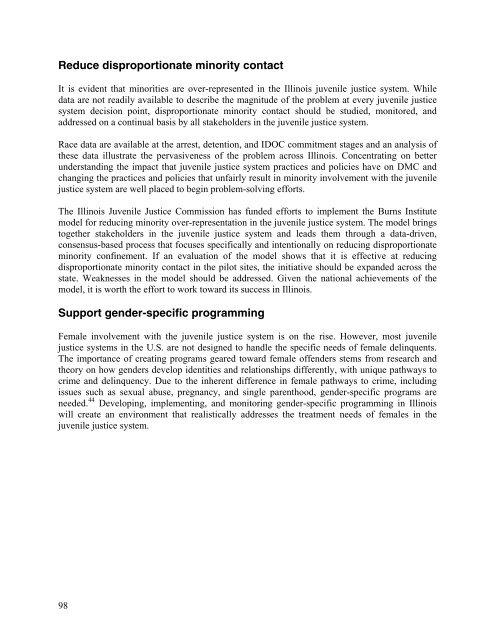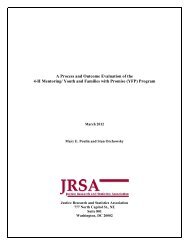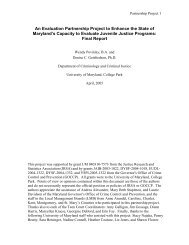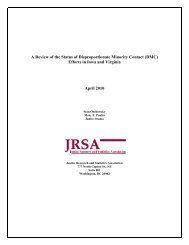Juvenile Justice System and Risk Factor Data - Illinois Criminal ...
Juvenile Justice System and Risk Factor Data - Illinois Criminal ...
Juvenile Justice System and Risk Factor Data - Illinois Criminal ...
Create successful ePaper yourself
Turn your PDF publications into a flip-book with our unique Google optimized e-Paper software.
Reduce disproportionate minority contact<br />
It is evident that minorities are over-represented in the <strong>Illinois</strong> juvenile justice system. While<br />
data are not readily available to describe the magnitude of the problem at every juvenile justice<br />
system decision point, disproportionate minority contact should be studied, monitored, <strong>and</strong><br />
addressed on a continual basis by all stakeholders in the juvenile justice system.<br />
Race data are available at the arrest, detention, <strong>and</strong> IDOC commitment stages <strong>and</strong> an analysis of<br />
these data illustrate the pervasiveness of the problem across <strong>Illinois</strong>. Concentrating on better<br />
underst<strong>and</strong>ing the impact that juvenile justice system practices <strong>and</strong> policies have on DMC <strong>and</strong><br />
changing the practices <strong>and</strong> policies that unfairly result in minority involvement with the juvenile<br />
justice system are well placed to begin problem-solving efforts.<br />
The <strong>Illinois</strong> <strong>Juvenile</strong> <strong>Justice</strong> Commission has funded efforts to implement the Burns Institute<br />
model for reducing minority over-representation in the juvenile justice system. The model brings<br />
together stakeholders in the juvenile justice system <strong>and</strong> leads them through a data-driven,<br />
consensus-based process that focuses specifically <strong>and</strong> intentionally on reducing disproportionate<br />
minority confinement. If an evaluation of the model shows that it is effective at reducing<br />
disproportionate minority contact in the pilot sites, the initiative should be exp<strong>and</strong>ed across the<br />
state. Weaknesses in the model should be addressed. Given the national achievements of the<br />
model, it is worth the effort to work toward its success in <strong>Illinois</strong>.<br />
Support gender-specific programming<br />
Female involvement with the juvenile justice system is on the rise. However, most juvenile<br />
justice systems in the U.S. are not designed to h<strong>and</strong>le the specific needs of female delinquents.<br />
The importance of creating programs geared toward female offenders stems from research <strong>and</strong><br />
theory on how genders develop identities <strong>and</strong> relationships differently, with unique pathways to<br />
crime <strong>and</strong> delinquency. Due to the inherent difference in female pathways to crime, including<br />
issues such as sexual abuse, pregnancy, <strong>and</strong> single parenthood, gender-specific programs are<br />
needed. 44 Developing, implementing, <strong>and</strong> monitoring gender-specific programming in <strong>Illinois</strong><br />
will create an environment that realistically addresses the treatment needs of females in the<br />
juvenile justice system.<br />
98

















